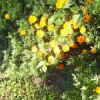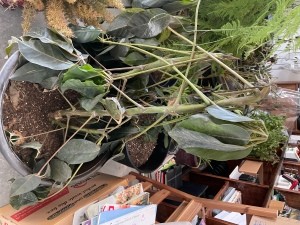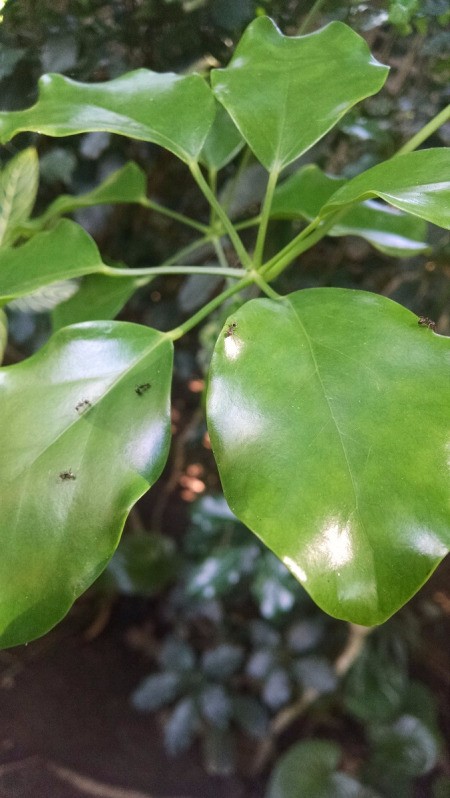
Ask a QuestionHere are the questions asked by community members. Read on to see the answers provided by the ThriftyFun community or ask a new question.
I think I may have killed my umbrella tree by overwatering it. It has totally turned dark. If I leave it will it come back?
First off if this is in a pot you should have it planted in a moss-base potting soil. If you don't then it needs to be changed out. With this type of soil, it makes it a lot easier to take care of the plant. You will only need to water this plant when the top soil is dry.
I would cut it back (look for the bumps on the stem and cut above the bumps). The bumps are places where there is growth so if you cut above it, it should come back.
They are a fairly hearty plant.
Post back with updates!
I have a 15 year old Scheffelera that was left outside during a hard freeze for a couple of days. I brought the plant inside and the leaves were drooping and brown.
I was advised to cut all the leaves off and trim it back a little. The branches were still green under the bark, but are now turning black. Is there anyway to save this tree? If I cut the branches all the way back can it still survive?
Hardiness Zone: 9a
By suzanne from Mandeville, LA

Scheffelera
The popular Brassaia actinophylla (schefflera or umbrella tree) has been widely grown for many years in Florida as an indoor foliage plant, while Schefflera arboricola (dwarf schefflera) has been of major importance since the mid 1970s. Other cultivars and varieties have become available during the past ten years with improved disease and pest resistance such as B. actinophylla `Amate'. Additionally, variegated cultivars of dwarf schefflera are constantly being introduced. The 1991 Florida Foliage Locator lists the following cultivars of S. arboricola; `Covette', `Gold Capella', `Jacqueline', `Renate', `Trinette', and `Variegata'. Although these scheffleras are available in virtually any size from 3 to 38 inch pots they are primarily available in 6 to 14 inch pots.
Schefflera arboricola can be from cuttings about 1 inch long below the leaf and taken from below the two uppermost fully developed leaves and above the lower oldest leaves. Seed of S. arboricola stored for 3 weeks at 65, 75, 85 or 95°F had germination percentages of 69, 75, 73 and 35, respectively, 3 weeks after planting compared to 93% germination of seeds planted immediately. Brassaia actinophylla are not generally propagated from cuttings although seeds and tissue cultured plantlets are commonly employed. Seed of B. actinophylla were reported to have a 67% germination when planted immediately.
Both schefflera and dwarf schefflera can be grown in full sun, but most plants are produced in 47 to 55% shade (approximately 5,000 to 7,000 foot-candles). High quality plants can be grown at this light level with a 3-1-2 ratio fertilizer, such as 9-3-6 or 18-6-12 at a rate of 1800 to 2400 lbs N/acre/year (equivalent to 41 to 55 lbs N/1000 square ft-year or 6 grams 19-6-12/6" pot and 10 grams/8" pot-3 months) plus micronutrients. Higher fertilizer levels will be necessary to produce plants of good quality if higher light levels are provided, but plants will not be acclimatized for interior conditions.
Good quality S. arboricola have been found to contain 2.8-3.7% dry weight N, 0.26-0.35% P, 2.5-3.5% K, 1.5-2.0% Ca and 0.4-1.0% Mg and good quality B. actinophylla contained 2.0-4.5% N, 0.15-0.50% P, 2.0-3.5% K, 0.5-1.8% Ca and 0.3-0.7% Mg. Good quality B. actinophylla was grown in a range of 2.5 to 10.2 mhos/cm when under 70 ft-c and 100-150 mhos x 10-5 when grown under 1200 ft-c.
Potting media used for schefflera must have good aeration, especially if plants are grown where they are subjected to rainfall, since root loss may be extensive during rainy periods when soil oxygen levels are low. Schefflera will tolerate 35 to 105°F without chilling or heat damage, but best growth and quality occur between 65 and 90°F. Schefflera `Gold Capello' was reported to bring greatest returns when grown at a minimum temperature of 60°F as opposed to 64 or 68 in Belgium during the winter. Brassaia actinophylla had less symptoms of Alternaria leaf spot when grown at a minimum night temperature of 75°F than at 60 and almost no symptoms when grown continuously at 80°F. S. arboricola grew taller and had better color when produced in 85% relative humidity compared to 60% relative humidity. B. actinophylla is very susceptible to ethylene. Both species can be shipped at 50-55°F for 4 weeks with slight loss of quality. Growth of S. arboricola was equal when grown indoors under fluorescent or incandescent light at equal intensities. Good luck.

Too often people throw out a damaged plant when there is still life in those sad stems - kudos to you for wanting to save yours. In fact, anything below 40 degrees for longer than a day will damage most potted tropical plants, so in the Southern Coasts region, it's wise to have a place indoors or on a protected porch to put the plants during cold weather. If the tops of the schefflera stems have wilted from cold and not revived, cut them off and put the plant where it will not be subject to freezing temperatures again so it can recover.
The result may be misshapen, and it is a good idea to prune the unaffected stems too, so the new growth will be produce well-shaped plant. Should the damage be more severe, and the entire plant looks ruined, don't give up until after you cut all the dead stems back, even to the top of the container. Although it looks like a goner, the roots may be alive and capable of sending up new stems. While the plant is in this distressed situation, be careful not to overwater, and use fertilizer sparingly if at all. Good luck.
I have cut my schefflera back a few times Suzanne and it has grown OK. The most recent time I air layered the plant and made two plants from the one as it became very leggy (spindley). Here are some pics of my air-layering if you would like to see them.
Did your plant survive? I have the same situation in the recent Texas winter freeze.... I am so sad. I hope mine live. I have brought it inside in a sunny room.

What to do when ur scheffelera has been outside for years n u cover them up cause of a freeze.... Now not sure when to prune the ?
I have a lovely Hawaiian Umbrella tree, it lives indoors, and is approximately 25 years old and quite healthy.
Recently, while visiting a local mall, I saw another Hawaiian Umbrella with the roots wrapped around the trunk: a banyan effect, but not random, and besides being quite attractive it had the added benefit of supporting the (by no means sturdy) trunk.
You know, I lived in a Banana Grove in Hawaii for three years, gardening my heart out with every plant I could find, but never heard nor saw a "Hawaiian Umbrella Tree". Does it have any other name? I'm very curious just what it could be. Does it bloom, fruit, or vine? Are the roots straight down? Perhaps the Hawaiians have a different name for it? Let me know if you know, o.k.? : )
Hi, Linda.
The Latin (proper) name for my tree is Arboricola schefflera, although mine isn't the dwarf variety. (Sorry about that; I should have thought to mention it, before.)
No fruit, no bloom (not in the 25 years I've owned it) and no vine. The roots are quite, quite long and thin and grow almost exclusively around the perimeter of the pot: around and around and around. I hope this description helps you identify it.
You lived in Hawaii? Lucky you! Gardening every day. How wonderful that must have been!
Cheers,
Rose Anne
This is known as the Dwarf Schefflera, and is considered one of the easiest plants to grow indoors.
It is tropical, grows wild up trees in Taiwan, Hawaii,
Austrailia, and perhaps itself? this accounts for the long "tendril" like roots, I suppose. lol I have one which I rescued from curbside back to health, but now have to rearrange my entry into a Winter greenhouse once again.
After 25 years, yours MUST be potbound, needing to be repotted. It is a judgment call whether or not to wrap the longest roots up it's trunk. It might do some strange things? I'd be more inclined to train it and it's tendrils into the tree form and train the roots to cling to a large wooden support of perhaps a 3" diameter rough
Cedar post?, tying it all the way to the very top and:
pull off any black/dry leaves,
watching that it doesn't get too moist, nor too dry
keeping an eye out for mites or scale
and perhaps feeding it a few used coffee grounds,
or Sea Kelp on its leaves.
It can be pruned back, if desired/needed, too, I understand from all I have read..and will recover well.
You must be doing all the right things to have kept it alive this long? Don't do too much that is drastic.
Yes, my days in Hawaii are mixed emotions, with the
fragrances of wild blooming trees and plants in abundance YEAR AROUND, growing every sort of plant there, seeing what we call ordinary Ivy growing to two foot wide leaves as high as the Mango trees were tall, right in our back yard, wtih the sounds of Hawaiian music heard 24 hours a day because Hawaii
seldom sleeps.
Once one gets used to the beauty and strangeness, it becomes more apparent that island living is both dangerous during a Tidal Wave/Tsunami or fire from Volcanoes, or shark
attacks in the surrounding waters for swimmers/surfers, and giving feelings of complete isolation from the world!
Yes, gardening there is a paradise, and it's where I studied Botanical subjects from the local Library for two of three years, day/night, attending Honolulu Beauty College the other year, when my husband was gone in the Military for months at a time.
It is a great place to visit but living there once is enough unless one is extremely wealthy and has their own plane/shipping line. lol It's a hard act to follow and few places ever satisfy you for a vacation once you've lived in Hawaii.
I saw several varieties of the Dwarf Scheffs with berries on Google Images, and yet, unless you want to take the chance, I'd be inclined to not try to force it to bloom with blooming food. Just see how well it grows with a few used Coffee Grounds and sprayed on liquid Sea Kelp.
Mine really likes both and perked up over night. I'm trying to figure out whether or not it has a multi-trunk
or is several plants in one pot, but hesitate to repot it just yet.
Good luck and hope this encourages you somehow.
God bless you. : )
I'd love to chat with you at greater length, Lynda. You sound fascinating! My personal e-mail is wordswork AT telusplanet.net if you'd care to be in touch.
Thanks kindly for the recommendations (particuarly the coffee grounds and kelp spray). I have repotted the thing several times over the years, but I still wonder about the 'dwarf' nomenclature as it 7 feet tall. I'm not sure about the mult-trunk aspect either, but that's neither here nor there at the moment.
When I consider wrapping the roots around the trunk, my principal concern is the roots dying. What portion should remain in the soil? Just the last, say, 3 feet? What I'm wondering about is simply this. Can I take the thing from it's pot, untangle all the roots, wrap them around the (several taller) trunks and then stick the last few feet of root back into the dirt? (Fresh pot, fresh dirt, of course.) Do I pack on some kind of growth medium (moss) and tie it over the exposed roots and keep it well moistened?
I'm asking a lot, I know. But I'd hate to lose the thing as it adds quite a nice feature to my home.
Cheers,
Rose Anne
How do I care for an umbrella tree? I found one that is almost a yard tall. Someone left it in my garbage room and it is in great shape. It is root bound and very thirsty. I gave it a nice drink today of my super vitamin water that I make for my cannabis plants (water, banana skins, and avocado shells) that I let sit for days. I figured that I would give it a nice drink before transplanting.
Great plant! Just a word of warning...if someone got rid of it, just be sure it does not have bugs before putting it with your other plants. I did this one (I am always rescuing plants) and one rescue had aphids that spread to several of my others before I finally figured it out. It was a big mess.
If the plant is clean and bug free, Umbrella Trees are very low maintenance.
They do need transplanted when every few years.
They are NOT water hogs...only water when they are dry.
They do not need fertilized, but that you gave them something should not hurt, I just would avoid future feedings.
Mine did well in indirect morning sun. Maybe others on this site have had luck in other light settings, but that always worked for me.
They tend to get a lot of dead leaves. Just pinch them off and it will be happier.
They are happy with some light and regular watering.
The Umbrella Tree can brighten up a room and needs very little attention.
I would suggest you maybe lay the tree on its side and rinse well with your garden hose before bringing it into your home - or even a bucket of water.
When transplanting, be sure to use loose soil and be sure the new container has very good drainage. Since this will be in your home, you may have to give this some thought and be sure you have a good under pan to catch any run off but never let it sit in water.
These like just slightly wet soil so be careful with watering.
Very little fertilizer, if any - is needed.
Likes indirect light and will get 'leggy' if light is too low.
Here are some links with full care instructions.
www.gardeningknowhow.com/
www.apartmenttherapy.com/
Share on ThriftyFunCheck out these photos. Click at right to share your own photo in this page.

Photo Description
The umbrella tree (or octopus tree) usually grows in a warm weather climate, its leaves are very useful in the flower arranging business and it is also a best seller in flower shops because of the catchy look and features of the leaf. The leaves are commonly used in churches, weddings, debuts, and many important occasions.
Photo Location
Dapitan City, Philippines